HeadRoom Total BitHead Portable Headphone Amplifier Review
By Chris Boylan
The Road Warrior's Secret Weapon
Back when I first started traveling, my options for taking music on the road were pretty limited -- I could bring my portable DAT recorder, a CD walkman, or I could sing out loud the themes from my favorite TV shows. I've tried all three and each had its advantages (singing "Gilligan's Island" in a loud voice generally frees up a few seats on an otherwise crowded plane). But even with the obvious portability advantages of MP3 -- being able to rip most of my CD collection onto my laptop's hard drive, or carry my music around on a petite portable music player -- I resisted the move to compressed transportable digital music.
You see, I'm a "purist" and no matter how many people claimed that MP3s encoded at 128, 160 or even 320 kbps were "CD quality," I didn't buy it. Artifacts like steeliness, brittle highs and artificial-sounding harmonics plagued my music, and I didn't like it. No sir. Of course, over time, with the advent of lossless compression formats, higher capacity hard drives, flash memory and MP3 players, my opinion of compressed digital music has softened.
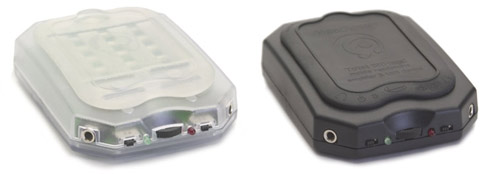
Headroom's Total BitHead in transparent and black case options.
And I love being able to take my music with my on my Treo or my laptop. But the fact remains that most laptops, MP3 players, smart phones, and lo even the mighty iPod, leave a bit to be desired in the quality of their internal D/A converters and headphone amplification circuits. What's a poor audiophile music lover to do? Well, that's where HeadRoom comes in with their line of portable high quality headphone amplifiers such as the HeadRoom Total BitHead.
At this point you may be thinking, "doesn't my iPod/laptop/MP3 player already have an amplifier built in? I mean, I can hear music just fine through my earbuds." The answer is, of course, yes -- your player or computer does have the ability to convert the digital bits and bytes that represent your music into an analog waveform, amplify the sound and send it to your earphones so you hear music -- just as a Ford Escort and a BMW M1 will both get you to your destination. And you'll get just as full on Spam sandwiches as you will on filet mignon and lobster, assuming you eat enough of it. External headphone amps are for those who want more from their music when they take it on the road, more dynamics, more quality, more realistic reproduction of sound... simply... more.
It's a Headphone Amp... It's a Soundcard... It's Both!
The Total Bithead is more than just an amplifier. The amplifier portion is important, of course. It adds some sonic heft to the anemic output of most portable music players and computers. It's like the difference between using a 5-watt amplifier to drive your home speaker system versus using a 100-watt amplifier for the same duty. At the very least, a headphone amp like the Total BitHead will allow your portable player to drive virtually any set of headphones to healthy sound levels, with plenty of dynamics, instead of the screechy strains that some portable players produce even at lower volumes.
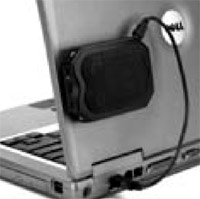
When stuck to a laptop, using the included Vel-coins, the BitHead tucks neatly out of the way.
But in addition to being a fine headphone amplifier, the Total BitHead is also a simple but effective portable sound card which can work with any computer with a USB output. In this capacity, the HeadRoom amp works directly on the digital contents of your music, making sure the translation back to the land of analog (which is necessary in order to make sound) happens as smoothly and gracefully as possible. This can effectively turn a cheap low-end laptop into a respectable portable music player as all the critical factors in transforming data into music -- the digital-to-analog stage and the amplification -- are performed by the BitHead.
But Wait, There's More!
In addition to its clean amplification and D/A capabilities, the Total BitHead also includes a (defeatable) spatial processing circuit called "Crossfeed," which can further enhance the realism of music. The Crossfeed circuit compensates for the fact that headphone listening is basically an artificial way of listening to music -- two speakers, jammed in your ears, just inches apart does not make for a realistic presentation of space and depth. With the Crossfeed circuit engaged, some of the signal from each ear is sent to the other ear, the net effect of which is a subtle, but noticeable improvement in spaciousness and image depth. It sounds more like the musicians are in real space and less like they're in your ears.
Hook Me Up
How you hook up your BitHead depends on your source device. If you have an iPod or mp3 player, you'll connect your player's line level or headphone level output to the line level input (mini-jack) on the amp. HeadRoom recommends setting the player's volume at around 75% of maximum in order to get the best results. With a laptop, desktop computer or Mac, simply plug the (included) USB cable's larger end into any available USB port on your computer or USB hub and the smaller end into the BitHead. Your computer should recognize the device and switch to it automatically, though you might need to close and re-open applications in order for the device to work.
On my Dell/Windows 2000 laptop, the device was immediately recognized (the O/S loaded the necessary driver from the BitHead itself), and it replaced the internal sound device by default. If you'd like to hear sound out of your PC speakers
and a pair of headphones, then simply plug the BitHead's second headphone output into your PC's line input, or switch over to the PC's internal sound card.
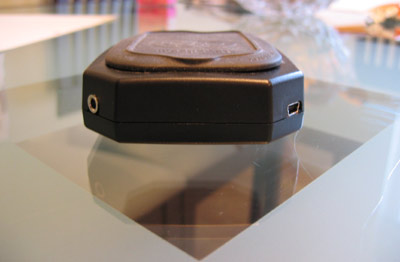
The BitHead accepts both a standard headphone/line input and a USB connection from a PC or Mac, but only one input is active at any one time.
You can even use the BitHead to add a headphone jack to any stereo system, DVD player or television. As long as the device has a line level output (left/right RCA jacks), you can use a simple stereo RCA to mini-jack cable (available at any Radio Shack or electronics store). Plug the RCA ends into the outputs of the device, and the mini-jack input into the BitHead, and use the BitHead's volume control to adjust the volume to your headphones.
Ergonomics and Features
The Total BitHead is well thought out and highly functional, particularly in the most recent (2006) revision. In addition to providing simple operation and connections, and a wide range of gain (amplification), the BitHead features some very nice touches. These illustrate the fact that the HeadRoom team actually considers the needs of actual end-users (that's us) when designing a product.
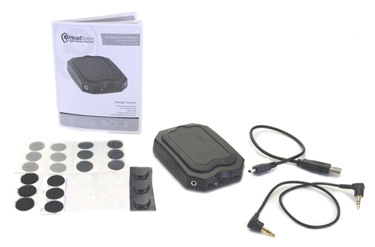
The BitHead comes with all the cables and velcro you'll need - just add batteries.
For example, using the USB input, you can choose to power the amp from its built-in AAA batteries (not included), or power it from the computer's USB connection instead. If you're on a plane without an external power source, use the batteries to extend your laptop's power, but if you're plugged in then switch the BitHead over to computer power to conserve its batteries. HeadRoom estimates the Total BitHead will last up to about 30 to 35 hours on a single set of 4 AAA batteries if used in battery-powered mode. This is a big improvement over the first HeadRoom amp I bought several years ago (the original version of the
Total AirHead), which lasted about 15 hours.
The battery cover itself is durable flexible rubber, which makes it an excellent non-slip platform for a portable player. The unit even comes with round Velcro stickers ("Vel-coins") that allow you to mount the amp directly on your laptop cover (and out of the way), or attach it to your portable player so you won't have to worry about having a lot of dangling cords.
About the only improvement they could make to the BitHead might be to make it a little thinner. Ipod nano fans probably won't be too crazy about carrying around a headphone amp that is three or four times the size of their player. But the size is a good match for a standard iPod, and works fine with laptops as well.
Listening Impressions
Ergonomics are utility are all well and good, but if the amp doesn't enhance the sound quality, then what's the point? And in this regard, the Total BitHead does not disappoint. When compared to regular (unamplified) output of a Treo 650, or standard iPod, the sound through the BitHead is more dynamic, with much better definition, better separation of individual instruments and voices in the mix and deeper more extended bass.
With the Crossfeed circuit engaged, you'll also get a more realistic presentation of soundstage depth with enhanced spatial resolution. The effect of the Crossfeed circuit is not dramatic -- but it is addictive. Switching back and forth with it on and off, the sound is just a little flat without it, and a little more robust and spacious with it. I also find that it reduces listening fatigue. I can listen to music for hours with the Total BitHead without my ears getting tired or getting a headache which sometimes happens when I listen to lesser quality portable music reproduction.
I tested the BitHead with many sets of 'phones, from inexpensive Sony earbuds to KOSS ESP 950 Electrostats to my trusty Etymotic ER4P in-ear earphones and the improvements were similar across the board. This little amp makes average headphones sound pretty good, and great headphones sound even better.
2006 Improvements
I began my Total BitHead adventure using the original version, but this was enhanced in 2006 with an additional gain adjustment (switchable) for cleanly driving lower impedence headphones as well as improvements to the internal amps and volume control circuitry. All this and a lower price (it dropped from $249 to $199). It's rare indeed that a product is simultaneously improved and lowered in price but that's just what happened with the Bithead.
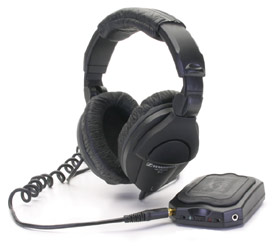
The BitHead can drive virtually any headphones to acceptable levels, even the mighty Sennheisers.
The new gain adjustment on the improved model allows the BitHead to drive the most and the least efficient headphones to suitable levels without excessive hiss or noise. Sennheiser is a well-known headphone brand among audiophiles. They make some really nice-sounding around the ear 'phones that are ideal for home music listening. But some Sennheiser models are low on the efficiency scale, which makes them difficult to use with portable players. On the flip-side, many popular in-ear earphone models such as the Etymotic Research
ER4P or
ER6i are very efficient, which means they don't need quite as much gain to reach adequate volume levels. With the improved BitHead you choose low gain or high gain to fit the specific headphones you're using. So you can take your Sennheisers or your Etymotics on the road and still hear every last detail in the music.
I also found a good use for the BitHead when transferring over web-based videos from my computer to a home DVD recorder. The headphone output of my laptop even at full volume was not able to generate a sound level high enough to be listenable on the target recording device. But with the BitHead in the loop, and the volume cranked, I was able to get good quality sound of adequate volume out of my laptop and capture these recordings to DVD on the home DVD recorder.
Final Thoughts
If you're getting the impression that I enjoyed my time with the BitHead you'd be right. It's a simple, flexible cost-effective upgrade to portable sound that can enhance your enjoyment of music and movies while on the road, or away from your main rig. It will improve the sound of virtually any PC, Mac, iPod or portable media player, and do so without a large investment or excessive extra baggage.
Your ears deserve it. Highly recommended.
Manufacturer's Specifications:- Type: Portable headphone amplifier
- Inputs: 1/8" stereo mini-headphone jack and mini-USB port.
- Output: 1/8" stereo mini-headphone jack (x2)
- Requires 4 AA batteries for portable operation (not included)
- Price: $199
- Available colors: black and transparent
- Dimensions: approximately 3" wide X 4.5" long X .75" thick
- Weight: about 7.5 ounces (with four AAA batteries inside)
What's in the Box:- Total BitHead headphone amplifier
- USB cable
- mini-to-mini cable
- 3 adhesive rubber feet
- Assortment of Vel-Coins (adhesive velcro feet)
- Owner's Manual
Company Information:
HeadRoom
2020 Gilkerson Drive
Bozeman, MT 59715
Voice: (406) 587-9466
Fax: (406) 587-9484.
Website:
www.headphone.com




